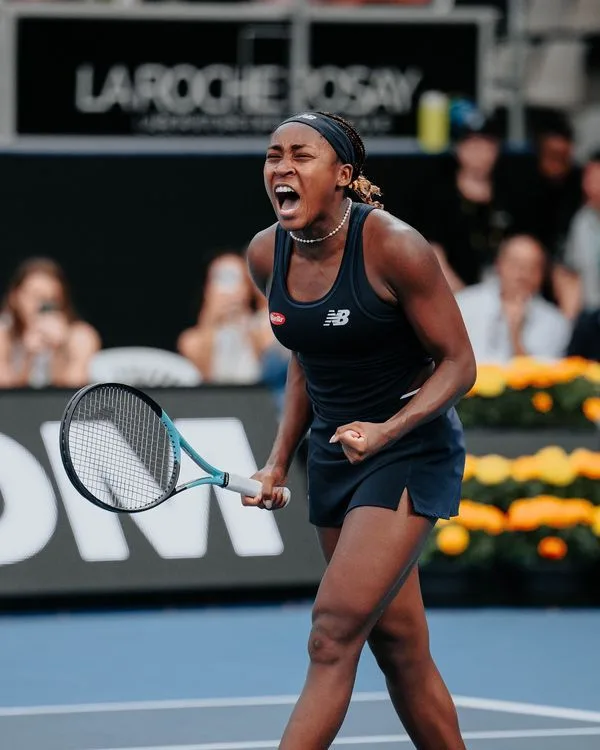“Bad Technique Breaks”- Coco Gauff Comes Under Scrutiny as Serena Williams’ Ex-Coach Highlights a Career-Long Concern

Coco Gauff, one of the brightest young stars in tennis, has captured the attention of fans and experts alike with her remarkable performances on the court. However, despite her undeniable talent, she has recently come under scrutiny due to concerns about her technique. This criticism, notably coming from Serena Williams’ former coach, has sparked a debate about the long-term sustainability of Gauff’s playing style and whether it could hinder her career progression.
The Rise of Coco Gauff
Gauff burst onto the tennis scene in 2019 when she defeated Venus Williams at Wimbledon at just 15 years old. Since then, she has consistently been viewed as one of the sport’s most promising young talents. Her athleticism, composure, and determination have earned her several victories on the WTA tour and the admiration of fans worldwide. At such a young age, she has already achieved significant milestones, including a Grand Slam title at the US Open, proving that she has the potential to dominate women’s tennis for years to come.
The Concerns About Her Technique
Despite her success, some tennis analysts have voiced concerns about certain technical aspects of Gauff’s game, particularly her forehand. Serena Williams’ ex-coach, whose expertise in developing top-tier players is well recognized, has pointed out that Gauff’s technique has flaws that could become more problematic as she faces higher-caliber opponents. The primary critique revolves around the mechanics of her forehand stroke, which some argue is inconsistent and lacks the fluidity necessary to generate power and control under pressure.
The Issue with Gauff’s Forehand
Gauff’s forehand has been a topic of discussion among analysts for years. While her backhand is widely regarded as one of the best on the tour, her forehand has often been viewed as a vulnerability. The concern stems from a combination of factors, including her grip, swing path, and timing. Experts have noted that her forehand tends to break down in high-stakes moments, particularly when she is under pressure from aggressive opponents who target that side.
One major issue is her take-back motion, which some believe is too large and cumbersome, making it difficult for her to react quickly to fast-paced shots. Additionally, her grip and wrist positioning sometimes lead to erratic ball placement, reducing her ability to consistently dictate points with her forehand. If left unaddressed, these technical flaws could prevent her from reaching her full potential and competing consistently at the highest level.
The Comparison to Serena Williams
Given that the critique comes from Serena Williams’ former coach, the comparison between Gauff and Williams is inevitable. Williams, known for her powerful and aggressive playing style, had one of the most formidable forehands in the history of the sport. Her ability to generate incredible racket head speed while maintaining precision and control was a key factor in her dominance. While Gauff has drawn comparisons to Williams in terms of her athleticism and fighting spirit, her forehand mechanics differ significantly from the 23-time Grand Slam champion.
Williams had a compact, efficient stroke that allowed her to strike the ball cleanly under pressure. In contrast, Gauff’s forehand has been described as more mechanical and prone to breaking down when faced with heavy hitters. The concern is that if she does not refine this aspect of her game, she may struggle to consistently defeat top-ranked players who can exploit this weakness.
The Path to Improvement
Despite these criticisms, Gauff has demonstrated an incredible ability to learn and adapt throughout her career. Many players have faced technical challenges early in their careers and have successfully made adjustments to enhance their performance. If Gauff can work on refining her forehand, she has the potential to become an even more dominant force in women’s tennis.
Technical Adjustments
To address the issues with her forehand, Gauff and her coaching team could consider making several adjustments:
- Shortening Her Take-Back – Reducing the length of her backswing could help her generate more controlled power and improve her reaction time against fast-paced opponents.
- Modifying Her Grip – Slight alterations in her grip could enhance her ability to hit with more topspin and control, reducing the likelihood of errors.
- Improving Footwork and Positioning – Ensuring that she is consistently in the right position to strike the ball cleanly could help stabilize her forehand and make it a more reliable weapon.
- Mental Conditioning – Given that technical flaws often become more apparent under pressure, mental training could help Gauff remain confident in her forehand even in crucial moments.
Learning from Other Players
Many top players have successfully refined their techniques mid-career. Rafael Nadal, for example, significantly adjusted his serve and forehand to improve his effectiveness on hard courts. Similarly, Novak Djokovic made adjustments to his serve that transformed his game and contributed to his dominance. Gauff has the advantage of being young and having ample time to make necessary changes without it significantly disrupting her career trajectory.
The Broader Perspective
While technical flaws are important to address, they do not define a player’s career. Tennis history is filled with players who have had unconventional techniques but still found ways to succeed. For instance, players like Maria Sharapova and Monica Seles had unique mechanics but adapted their games to maximize their strengths. Gauff’s ability to overcome adversity and learn from her experiences will be crucial in determining her future success.
The Mental and Physical Edge
One of Gauff’s greatest strengths is her mental fortitude. She has already demonstrated an ability to handle high-pressure situations with maturity beyond her years. Additionally, her athleticism gives her a significant advantage over many of her competitors. Even if her forehand remains a work in progress, her speed, defensive skills, and tactical awareness can help compensate for any technical shortcomings.
Conclusion
Coco Gauff is undoubtedly one of the most exciting talents in women’s tennis today. While concerns about her forehand have been raised by experts, including Serena Williams’ former coach, these critiques should be seen as opportunities for growth rather than definitive limitations. With the right adjustments and continued dedication to improvement, Gauff has the potential to refine her technique and become an even greater force in the sport.
The road to greatness is rarely without obstacles, and many of the greatest tennis players have had to overcome technical challenges to reach their peak. If Gauff can successfully address the concerns surrounding her forehand, she will not only silence the critics but also elevate her game to a level where she can dominate the tour for years to come. Tennis fans around the world will be watching closely to see how she evolves, and if history has shown anything, it is that champions always find a way to adapt and thrive.







